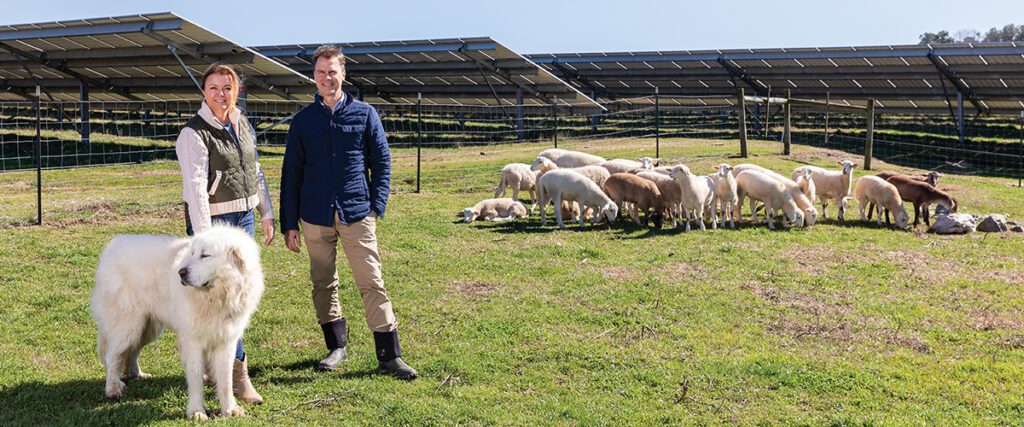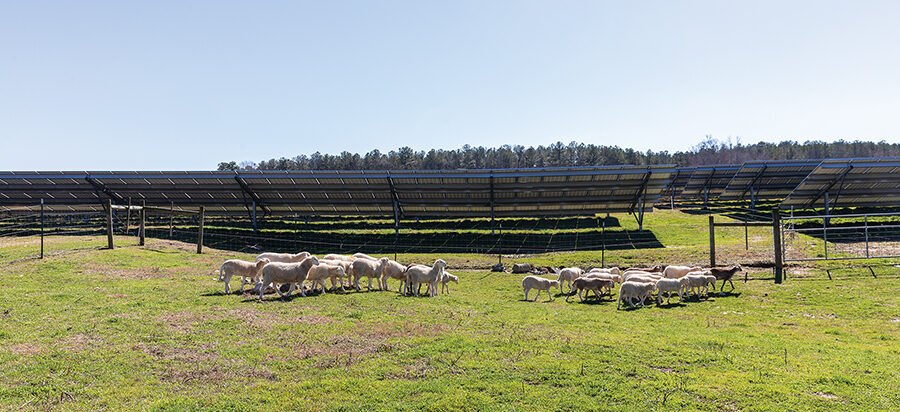Sun-Raised Sheep

Farming at the bleating edge
By Jenna Biter
Photographs by John Gessner
Peafowl nap high in the rafters of a classic red barn. One bird, awakened by a buzz buzz buzzing, pecks a housefly out of the air like Mr. Miyagi with chopsticks. And the buzzing stops.
Now, the peacock is presumably less irritated, as well as less hungry, and the fly can’t buzz down to the wobbly-legged lambs, whose developing immune systems are better off without whatever infections the insect might be spreading.
The lambs’ young stomachs aren’t even strong enough to digest what will become their steady diet of grass. When they do grow strong enough, at a couple of months old, they’ll leave the red barn to join the flock munching its way across a quilt of pastures tucked down a gravel drive beside a flea market in Biscoe.
A few westward turns out of Moore County and into Montgomery, the 500-head Katahdin flock grazes beneath the shade of solar panels, where the Old World meets the Ewe, uh, New.
“They use this word ‘agrivoltaics,’” says Joel Olsen, a Charlotte native who owns the Montgomery Sheep Farm, with his wife, Tonje, “which doesn’t mean anything to most people.” That’s something the couple seems on a mission to change.

To people who do know, agrivoltaics is a techy sort of twofer: It’s when a solar farm moonlights as a traditional crop farm or, as with the Olsens, a livestock farm.
“The power here at the farm goes into the local grid, and this . . . ” Joel trails off in search of the right explanation. “Right now,” he says, “we’re powering all of Biscoe and Star — every single home, school, business, factory.”
He looks out at the gleaming fields of silvery tech, more than 100,000 solar panels in all.
“It’s a ton of power, 28 megawatts,” he says, delight warming his Carolina accent. While the solar panels stare up at the sun, quietly collecting golden rays to redistribute as green energy, the flock, unbeknownst to them, is on the clock.
With each happy chomp, the sheep mow the grass beneath and between the panel rows, so the greenery doesn’t shoot up and disrupt the solar harvest.
“When you get shade, it reduces your output, it reduces your income,” Joel says. Despite the clear cause and effect, during the early days of O2 — the name of his N.C. solar development company — he learned that solar farm groundskeeping was often overlooked, low budget, and the first thing to go wrong.
In 2012, the Olsens set out to change the status quo.
With a nostalgia for the lamb dishes of her childhood in Norway — where country sheep, geolocated by bells tinkling on their collars, foraged freely in the summertime — Tonje created Sun Raised Farms, a matchmaking agribusiness that pairs solar farms with ovine maintainers.
“We try to find the best sheep farmers in the area, so they can get free pasture for their lambs on the solar farm, and then we pay them to maintain it,” Tonje says. What can’t be grazed due to natural or technological terrain, Sun Raised Farms hires a human crew to care for.
“It’s kind of a win-win for the farmers,” Tonje says with a smile.
In the next instant, Joel flashes back in time to the beginning of their hike up agrivoltaics’ steep learning curve, a path that originally rejected them like Sisyphus.
“We had a local 21-year-old who bought 13 sheep to put on our first solar farm, and after two weeks, the neighbor’s hunting dogs got out, went right through a hole in the fence, and killed them all,” he says with a disapproving cluck. “That was step one.”
Joel guesstimates that now — with nearly two dozen solar parks under the management of Sun Raised Farms and more than a decade into the learning curve — the Olsens are about 17 steps into their agrivoltaics project. Since 2016, the endeavor has included the Montgomery Sheep Farm, what the Olsens view as a sort of research hub to establish best practices for their farming partners.
Cursed with what Joel characterizes as chalky, inhospitable soil, the century-old property began as a failed farm called the Tobacco Stick Ranch, and then transitioned into a hunting preserve. Its five minutes of fame came in 2006 when The Daily Show’s Nate Corddry used the name and the grounds in a sketch poking fun at then-Vice President Dick Cheney for blasting fellow quail hunter Harry Whittington with birdshot — an incident that actually happened in Texas.
Now the tobacco barn, workshop, farmhouse — all of the compound’s eight or so buildings — have been rehabilitated into a working farm wired into its own private solar microgrid, independent from the panels that feed the community grid.
Via a network of electrical boxes, a solar carport and four Tesla Powerwall 2 batteries hidden away in a mudroom, the farm powers itself most of the time.
“It’s one of the first off-grid farms in the country,” Joel says. “It demonstrates that farms can not only raise their own food, but also generate electricity for their own operations.”
In the distance, the techno-farm’s big power plant is a metallic patchwork that blankets 120 of the property’s 200 sprawling acres. Amidst the panels, inverters and breakers, a labyrinth of thigh-high electric fencing partitions the sheep into 28 micro-pastures, so they don’t overgraze any one section.
Though divided into smaller flocks, the sheep bleat back and forth in a never-ending game of barnyard Marco Polo. White-blond dogs stand watch nearby, wagging their tails. They don’t seem to speak sheep.
By day, the dogs live up to their gentle names like Elsa, Casper and Luna, politely asking for pats with their heads lowered in obeisance. By night, these Great Pyrenees protectors channel their pedigree to fend off coyotes and foxes lurking just beyond the chicken-wire fence.
Across a dirt road, back inside the red barn, the peafowl, some doves and a turkey dutifully continue their watch over the 100 young lambs. At the far end of the barn, a barrel-chested rooster seems preoccupied. He perches self-importantly on the back of a ewe, as if he’s directing a barnyard rehearsal for one of the farm tours that roll through every spring and fall.
Like the circle of life, the tours always end in dinner: a sun-powered, four-course, farm-to-table meal featuring the Montgomery Sheep Farm’s lamb by way of Sun Raised Foods, the Olsens’ avenue for bringing their farmers’ stock to market.
“A lot of the criticism solar farm developers received was because they took farmland away from the community,” Tonje says. “With this model, they kind of give back.” PS
Jenna Biter is a writer and military wife in the Sandhills. She can be reached at jennabiter@protonmail.com. You can purchase tickets for a Montgomery Sheep Farm tour and dinner at sunraisedfoods.com.
